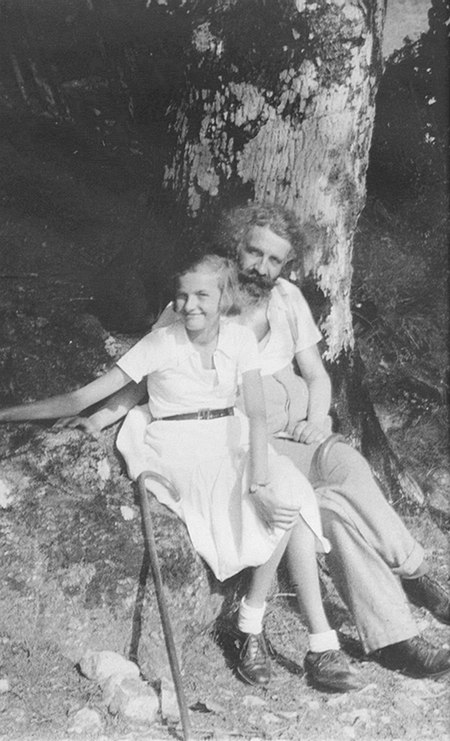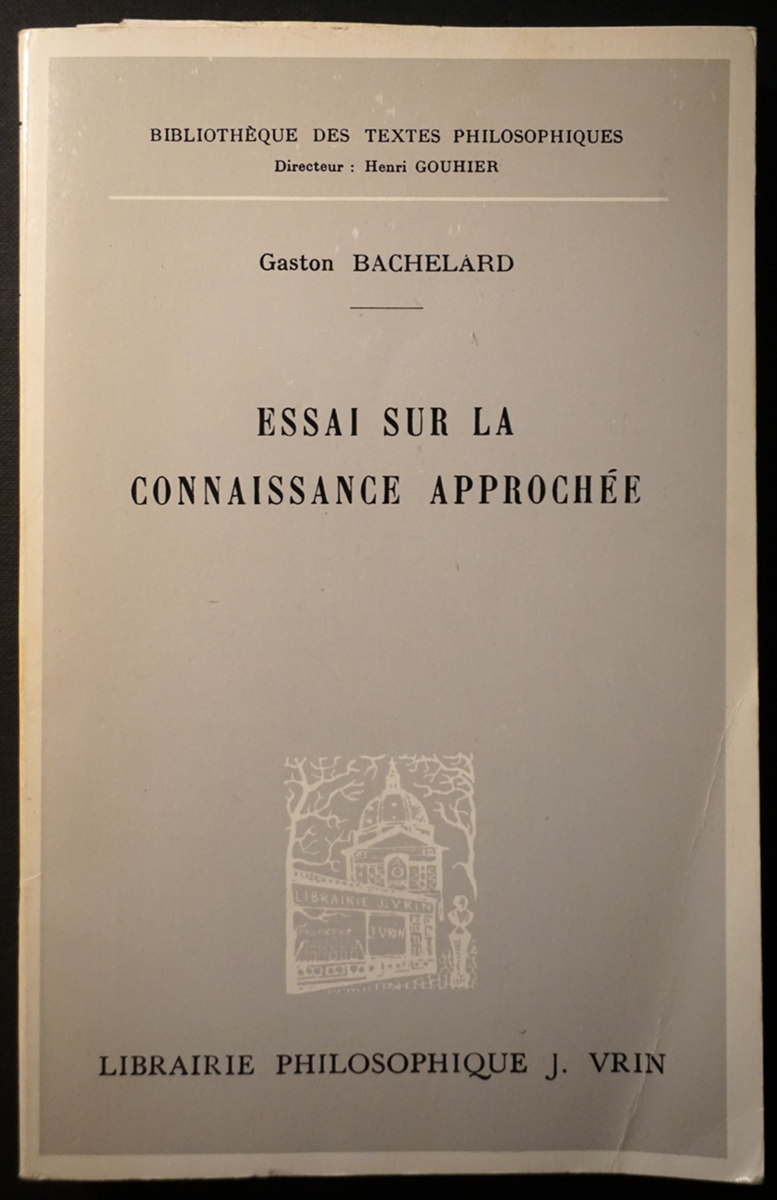Reading the second chapter of Hans-Jörg Rheinberger‘s ‘Epistemologie des Konkreten’ triggered me to start reading Gaston Bachelards writings on the philosophy of science and epistemology. I started with his ‘Essai sur la connaissance approchée’ (1927), which is in fact his doctoral thesis and (I suppose) the first book he wrote.
The following two pages struck a chord, and I am reproducing them here in the original French (from the fourth edition in 1973, pp. 52-54) and in my own, undoubtedly rather crude, English translation; as far as I know this has not been published in English anywhere:
C’est par la mesure précise que l’objet peut se révéler comme permanent et fixe, c’est-à-dire qu’il est vraiment reconnu comme objet. Au sujet d’un jugement qualitatif, les divergences eussent au contraire été si nettes que le consensus même limité par le correctif des circonstances connexes eût manqué d’unanimité et d’énergie. Il n’apparaîtrait qu’en se contentant d’une ordination fortement et grossièrement rythmée. Et pourtant, que ce soit dans la mesure ou dans une comparaison qualitative, il n’y a toujours qu’un jugement sur un ordre : un point vient après un autre, une couleur est plus ou moins rouge qu’une autre. Mais la précision emporte tout, elle donne à la certitude un caractère si solide que la connaissance nous semble vraiment concrète et utile ; elle nous donne l’illusion de toucher le réel. Voulez-vous croire au réel, mesurez-le.
On pourrait donc énoncer à la base de la physique moderne ce double postulat métaphysique : ce qu’on mesure existe et on le connaît dans la proportion où la mesure est précise. Cette double affirmation condenserait toute l’ontologie scientifique et toute l’épistémologie du physicien. Ainsi, dès le début, subrepticement, une métaphysique s’est établie que le développement monotone des mesures ne troublera pas. On aura à la fois incorporé une ontologie rudimentaire et une définition de la connaissance qui présente si peu d’exigences qu’elle sera valable à tous les niveaux de la doctrine. Tous nos moyens de connaître s’effaceraient devant cette comparaison d’un type très spécial qu’est une mesure. Toutes les relations du monde sensible devraient se traduire, pour être comprises d’une manière satisfaisante, dans cette mathématique assez pauvre qui s’adapte à la mesure. La mesure apparaît ainsi comme l’épistémologie fondamentale, comme la base de l’arithmétisation de l’expérience. Et d’un autre côté c’est la mesure qui garantit la permanence de l’être, qui intègre cet être dans sa juste place et qui justifie finalement l’ontologie scientifique.
Cette ontologie doit sa solidité à la pauvreté de son principe. Elle est une doctrine de l’être en soi très peu qualifié et même qualifié au minimum. Dès qu’on accepte un objet revêtu des qualités multiples, on accède rapidement à la notion d’apparence. D’abord cette multiplicité, pour peu qu’elle dépasse en richesse un certain niveau, n’est plus recensée par l’esprit. Elle donne naissance en outre à des concepts complexes qui peuvent être si prolixes que chacun d’eux semble dépourvu d’extension et calque une individualité. Aucun genre, aucune loi. Le Devenir se brise lui-même en des devenirs partiels et particuliers, sans accord et sans harmonie. Chaque objet prend un aspect et un rythme. L’être est étouffé par ses attributs. Mais à prendre contact avec les attributs de l’être, l’esprit se rend compte du rôle qu’il joue. Les lois de la représentation apparaissent alors comme les véritables principes de la stabilité des choses au détriment d’un substantif qui n’est plus qu’un outil verbal. On s’écarte définitivement de l’ontologie.
Il n’en est plus de même si l’on restreint le nombre des prédicats étudiés et surtout si l’on choisit le plus stable d’entre eux pour le marquer d’une valeur épistémologique particulière. Au point de vue de la connaissance, ce choix est arbitraire, mais il est heureux. L’objet en reçoit une fixité qui va lui permettre de résister à l’entraînement qualitatif général. L’esprit ne cherchant plus que des vérifications d’ordre quantitatif est amené à prendre tout ce qui est quantifié pour réel. Le réel se dépouille, mais se stabilise. À écarter tant de qualités secondes on croit toucher des qualités premières. On croit tenir le sujet parce qu’on a évincé des attributs. On croit penser enfin le substantif puisqu’on n’en considère qu’un substitut. L’occasion ne se représentera plus de réduire ce sophisme ontologique, car toutes les fois qu’on réduira des propriétés au prédicat fondamental, on croira les avoir rapportées à l’être et atteint le terme de l’explication. La quantité n’est pourtant qu’un prédicat comme les autres. Mais la mathématique qui l’exprime est toute prête, c’est une science qui a une telle avance sur les autres moyens de connaître qu’elle les absorbe tous. C’est la source de toutes les métaphores précises. De sorte qu’à force de regarder l’être sous la catégorie de la quantité, on imagine qu’il est réglé sur le nombre. L’expression donne sa coordination à l’exprimé, et cette coordination est si solide qu’on croit toucher le lien de l’être en soi.

And in my English translation:
It is through precise measurement that the object can show itself as permanent and fixed, that it is truly recognized as an object. In the case of a qualitative judgement, divergences would have been so distinct, that even when corrected by related circumstances, any consensus would have been lacking in unanimity and energy. Consensus would only occur if one would settle for a forced and crudely grouped ordering. And yet, both in measuring and in qualitative comparison there is always a judgement about order: one point comes after another, a colour is less or more red than another. But precision sweeps everything along, it gives such a solid character to certitude, that the knowledge seems really concrete and useful to us; it gives us the illusion of touching the real. If you want to believe in the real, measure it.
So we could say that there is this double metaphysical postulate at the basis of modern physics: what we measure exists and we know it in proportion to the precision of measurement. This double assertion condenses the whole scientific ontology and the whole epistemology of the physicist. In this way, from the start and surreptitiously, a metaphysics has established itself that will not be troubled by the monotonous development of measurement. It incorporates at the same time a rudimentary ontology as well as a definition of knowledge that has so few requirements that it would be valid at all levels of the doctrine. All our means of knowing will vanish before that very special type of comparison that is measurement. In order to be understood in a satisfactory way, all the connections of the perceptible world would have to be translated into that rather poor mathematics that adapts itself to measurement. Measurement appears as the fundamental epistemology, as the basis of the arithmetisation of experience. And on the other hand it is measurement that guarantees the permancence of being, that integrates that being into its rightful place and that in the end justifies the scientific ontology.
This ontology owes its solidity to the poverty of its principle. It is a doctrine of being as such that is hardly qualified and even qualified to an absolute minimum. As soon as we accept an object clothed in multiple qualities, we quickly get to the notion of appearance. In the first place, as soon as it goes beyond a certain level of richness, this multiplicity is not registered anymore by the mind. Furthermore, it gives birth to complex concepts that can be so diffuse that each of them seems devoid of extension and traces an individuality. No categories, no laws. Becoming shatters itself in partial and particular becomings, without agreement and without harmony. Every object takes on its own appearance and rhythm. Being is suffocated by its attributes. But by getting in touch with the attributes of being, the mind notices the role it plays. The laws of representation then appear as the true principles of the stability of things, at the expense of a noun that is not more than a verbal tool. We definitively separate ourselves from ontology.
It is not the same anymore if we restrict the number of predicates studied and especially if we choose the most stable among them in order to mark a particular epistemological value. From the point of view of knowledge, this choice is arbitrary, but lucky. It gives the object a fixity that will allow it to resist the general qualitative drive. When the mind is left only to look for verifications of a quantitative order, it is inclined to take everything that is quantified for real. The real is dismantled, but stabilizes itself. By getting rid of so many secondary qualities, we believe that we are touching the primary qualities. We believe that we hold the subject since we have pushed the attributes aside. We believe we can finally think the substantive because we are only considering a substitute. There will be no longer an opportunity to eliminate this ontological sophism, because every time we reduce properties to a fundamental predicate, we will believe that we have related them to being and that we have reached the terminus of explanation. Even though quantity is a predicate as any other. But the mathematics that expresses it is ready to be found, it’s a science that is so ahead of other ways of knowing that it absorbs them all. It is the source of all precise metaphors, so that by looking at being under the category of quantity, we imagine that it is determined by number. The expression coordinates that what is being expressed, and that coordination is so solid, that we believe that we are touching on the connection to being as such.

